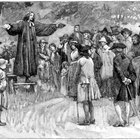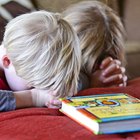According to Education.com, young children begin to lie, and one way to teach them morals about honesty is through stories. The website states that books entice young children and explain the consequences of lying and dishonesty, while not shaming the child for lying. It also allows you to ask young children what they would do differently in the character’s position.
Books
Use the book “The Berenstain Bears and the Truth,” by Stan & Jan Berenstain, to explore the themes of honesty and truth-telling with older preschoolers. Begin the lesson by showing your class the cover of the book, which shows the cubs next to a broken lamp and a large bird hitting it in a daydream bubble. Show them other illustrations throughout the book to highlight the theme of the story.
Ask your class what they think the story will focus on, before starting to read aloud. Stop at intervals, asking students to share if they would have chosen to make the same choices as Brother and Sister Bear and to predict what might happen to the cubs next. After the story, write the word “Honesty” on bulletin board paper and ask the children what it means to them, such as feeling proud when telling the truth. The Solution Site, which provides lessons for teachers, suggests completing the lesson by having students draw a picture of a time they lied.
Fables
Introduce this lesson on honesty by reading Aesop’s classic fable “The Boy Who Cried Wolf,” featuring the young shepherd boy who kept villagers running to help him by screaming that a wolf was chasing his flock of sheep. But when a wolf really did scare his flock, none of the villagers came to his rescue and the sheep ran away because no one believed him.
Discuss important elements of a fable, such as the main character learning a lesson or solving a problem, or choosing between good and evil. The lesson plans from Teacher Scholastic recommend analyzing the concepts of honesty and responsibility with your students and defining what they think each one means, as well as choosing better options for the shepherd boy. Talk about the importance of earning trust back after lying, and have the children share their dishonest experiences.
Character Cards
The website Building Blocks for a Healthier Future recommends using over-sized character cards, showing an animal with statements about it, such as "Thurgood the Turtle likes golf like Tiger Woods," or "Kristi Kitty enjoys planting flowers." Hold up a character card, describing something about the picture, such as "Mee Possum hates swimming," which the students would say is untrue because she loves swimming, which the students could see from the picture and description. After playing the game, discuss the importance of telling the truth with your class.
Related Articles

Children's Activities for the Parable ...

Christian Graduation Party Ideas

Valentine Bible Stories for Children

Children's Games to Teach About ...

Sunday School Lessons for Teenagers

Activities for Bedridden Children

Children's Activities About Sin

Children's Bible Lesson Plans & ...

Characteristics of Fables for Kids

Free Youth Activities on Faith

Fun Christian Youth Activities on ...

Easter Sunday School Lessons for Teens

Valentine's Day Party Games for School- ...

Preschool Bible Crafts & Activities on ...

Children's Games That Demonstrate Faith

Mother's Day Sunday School Lessons

Youth Christian Devotion Activities

Fun Games for Sunday School Kids Ages ...

Sunday School Games About Prayer

How to Deal With Someone Who Accuses ...
References
Writer Bio
Laura Nowak is a freelance writer who combines her love of travel and research to write travel articles. She has been published in various print and online publications, including the "Western Herald," where she wrote arts and entertainment articles. Nowak earned a Bachelor of Arts degree in practical writing from Western Michigan University.